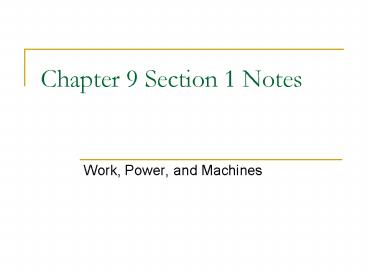Chapter 9 Section 1 Notes PowerPoint PPT Presentation
1 / 15
Title: Chapter 9 Section 1 Notes
1
Chapter 9 Section 1 Notes
- Work, Power, and Machines
2
What is Work?
- Work is done only when a force causes a change in
motion of an object. - Work is done by a force on an object.
- Work is calculated by multiplying the force by
the distance over which the force is applied. - Work Force x distance W F x d
3
Work
- If the distance something moves is zero, there
has been no work done - Example If you are trying to push a car stuck in
the mud it doesnt go anywhere, you have done
no work because the distance moved is zero. But,
you have applied a force.
4
Work
- Work is measured in Joules.
- All of these units are equivalent 1 N m 1 J
1 kg m2/s2 - You do 1 Joule of work when you lift an apple,
which weighs 1 N, from your arms length down at
your side to the top of your head (1 meter).
5
Work sample problem
- Nick lifts a 0.150 kg sandwich 0.30 m from the
table to his mouth. How much work does he do? - Solution
6
Power
- Power measures the rate at which work is done,
or, how much work is done in a certain amount of
time. - Power work/time P W/t
- SI unit for power Watt (W)
- A watt is the amount of power required to do 1 J
of work in 1 s.
7
Power sample problem
- While rowing across the lake during a race, John
does 3960 J of work on the oars in 60.0 s. What
is his power output in watts? - Solution
8
Machines and Mechanical Advantage
- Machines multiply and redirect forces.
- Machines help to do work by redistributing the
work we put into them.
9
Machines
- Machines can
- Change the direction of the input force
- Increase output force by changing the distance
over which the force is applied called
multiplying the force.
10
Machines
- You can do the same amount of work while applying
a different force. Why? - As force decreases, the distance increases, so
you are doing the same amount of work. - Machines make work easier by increasing the
distance over which force is applied.
11
Mechanical Advantage
- Mechanical Advantage (abbreviated MA) tells us
how much a machine multiplies force or increases
distance. - Equation MA output force input distance
- input force output distance
- If MA gt1 multiplies the input force helps you
move or lift a heavy object, such as a car. - If MA lt1 increases distance and speed.
12
Mechanical Advantage
- Example Find the MA of a ramp that is 6.0 m long
and 1.5 m tall. - Example Alex pulls on the handle of a claw
hammer with a force of 15 N. If the hammer has a
MA of 5.2, how much force is exerted on the nail
in the claw?
13
G Force
- G Force is a measurement of an object's
acceleration expressed in g's. It may also
informally refer to the reaction force resulting
from an acceleration, with the causing
acceleration expressed in g's. - G force acts on all body parts, including organs,
which are only loosely connected together
14
- In 1954, John Paul Stapp experienced 46.2 g all
for science. He was strapped into a
rocket-powered sled on train tracks and
decelerated from 630 mph to 0 in 1.25 seconds.
This is the same as hitting a brick wall at
120mph! He survived, but his eyes filled with
blood and he was temporarily blinded in what is
called a red out.
15
Video of John Paul Stapp

